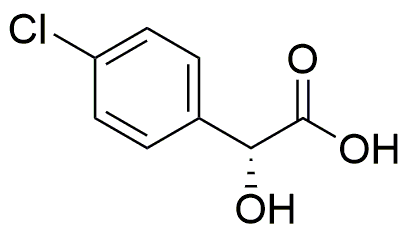4-Chloro-D-mandelic acid is widely utilized in research focused on:
- Pharmaceutical Development: This compound serves as an important intermediate in the synthesis of various pharmaceuticals, particularly in the development of anti-inflammatory and analgesic drugs.
- Chiral Synthesis: Its chiral nature makes it valuable in asymmetric synthesis, allowing chemists to create specific enantiomers that are crucial in drug formulation.
- Analytical Chemistry: Used as a standard in chromatographic techniques, it aids in the quantification of other compounds, ensuring accurate analysis in quality control processes.
- Cosmetic Formulations: The compound is incorporated into skincare products for its potential skin-soothing properties, enhancing the effectiveness of formulations aimed at sensitive skin.
- Research in Biochemistry: It is utilized in studies exploring metabolic pathways and enzyme interactions, providing insights into biochemical processes relevant to health and disease.
General Information
Properties
Safety and Regulations
Applications
4-Chloro-D-mandelic acid is widely utilized in research focused on:
- Pharmaceutical Development: This compound serves as an important intermediate in the synthesis of various pharmaceuticals, particularly in the development of anti-inflammatory and analgesic drugs.
- Chiral Synthesis: Its chiral nature makes it valuable in asymmetric synthesis, allowing chemists to create specific enantiomers that are crucial in drug formulation.
- Analytical Chemistry: Used as a standard in chromatographic techniques, it aids in the quantification of other compounds, ensuring accurate analysis in quality control processes.
- Cosmetic Formulations: The compound is incorporated into skincare products for its potential skin-soothing properties, enhancing the effectiveness of formulations aimed at sensitive skin.
- Research in Biochemistry: It is utilized in studies exploring metabolic pathways and enzyme interactions, providing insights into biochemical processes relevant to health and disease.
Documents
Safety Data Sheets (SDS)
The SDS provides comprehensive safety information on handling, storage, and disposal of the product.
Product Specification (PS)
The PS provides a comprehensive breakdown of the product’s properties, including chemical composition, physical state, purity, and storage requirements. It also details acceptable quality ranges and the product's intended applications.
Certificates of Analysis (COA)
Search for Certificates of Analysis (COA) by entering the products Lot Number. Lot and Batch Numbers can be found on a product’s label following the words ‘Lot’ or ‘Batch’.
Número de catálogo
Número de lote/lote
Certificates Of Origin (COO)
This COO confirms the country where the product was manufactured, and also details the materials and components used in it and whether it is derived from natural, synthetic, or other specific sources. This certificate may be required for customs, trade, and regulatory compliance.
Número de catálogo
Número de lote/lote
Safety Data Sheets (SDS)
The SDS provides comprehensive safety information on handling, storage, and disposal of the product.
DownloadProduct Specification (PS)
The PS provides a comprehensive breakdown of the product’s properties, including chemical composition, physical state, purity, and storage requirements. It also details acceptable quality ranges and the product's intended applications.
DownloadCertificates of Analysis (COA)
Search for Certificates of Analysis (COA) by entering the products Lot Number. Lot and Batch Numbers can be found on a product’s label following the words ‘Lot’ or ‘Batch’.
Número de catálogo
Número de lote/lote
Certificates Of Origin (COO)
This COO confirms the country where the product was manufactured, and also details the materials and components used in it and whether it is derived from natural, synthetic, or other specific sources. This certificate may be required for customs, trade, and regulatory compliance.


